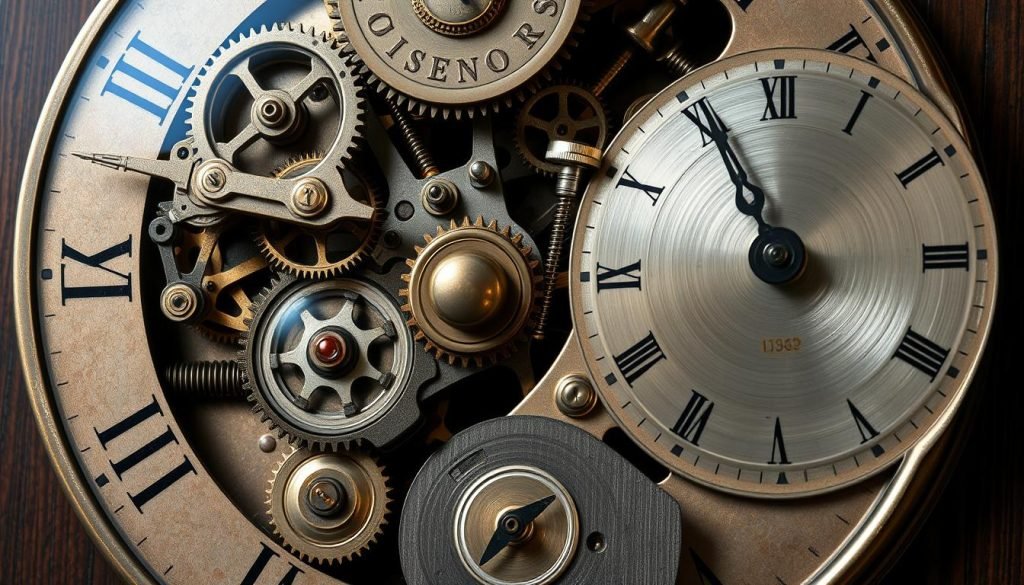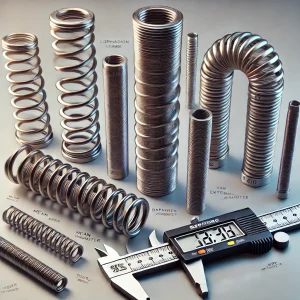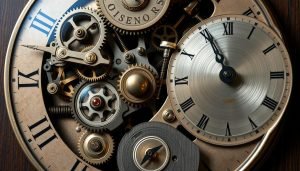Clocks are essential in our daily lives, and their inner workings are truly fascinating. At the core of many clocks are springs, which are key to keeping time. Learning about clock mechanisms and the role of springs helps us appreciate the art of timekeeping.
Timekeeping has come a long way, with many clock mechanisms developed over time. Springs have been a big part of this progress, making clocks more precise and reliable.
Exploring clock mechanisms and springs can be very enlightening. It shows us the complexity of timekeeping and the importance of springs. As we dive into the anatomy of timekeeping, we’ll see how these elements have influenced how we measure time.
Understanding the Basics of Clock Mechanics
Clocks have been important to humans for centuries. Their mechanics have changed a lot over time. To get the details of timekeeping, knowing the basic parts of a clock is key. Mechanical clocks use gears, springs, and balance wheels to keep time accurately.
The movement system is at the heart of every clock. It measures time. This system has many gears that get power from a precision timepiece‘s mainspring or battery. This is what makes clocks keep accurate time, making clock maintenance very important.
Essential Components of a Clock
- Dial: The face of the clock, which displays the time
- Hands: The hour, minute, and second hands that rotate to indicate time
- Movement system: The mechanism that powers the clock’s timekeeping functions
Knowing how these parts work together is key to understanding clockmaking. By seeing the value of precision timepieces and mechanical clocks in our lives, we can appreciate the skill in making them. Keeping our clocks well-maintained is also key to their accuracy.
The History of Springs in Timekeeping
The story of clock history is truly captivating. It shows how springs in clocks have evolved over time. Springs have been key in making clocks more accurate and reliable. This change led to the modern ways we keep time today.
The use of mainsprings was a major breakthrough. It made clocks more precise. Then, balance springs were introduced, making timekeeping even more accurate. These advancements in springs in clocks have shaped the history of innovative timekeeping.
Some important moments in the history of springs in timekeeping include:
- The introduction of pocket watches, which relied on springs for their mechanism
- The development of precision timepieces, such as those used in scientific and astronomical applications
- The creation of modern clock movements, which often combine traditional spring-based mechanisms with modern materials and technologies
These developments have enriched clock history. They have also driven the evolution of innovative timekeeping methods. Springs in clocks remain essential in many timekeeping devices today.
Do Clocks Have Springs? Types and Functions
Clocks have been important to humans for centuries. Their parts have changed a lot over time. In mechanical clocks, springs are key to how they work. There are mainly two types of springs: mainsprings and balance springs.
Mainsprings store energy in mechanical clocks. This energy moves the clock’s hands. Balance springs, on the other hand, help precision timepieces keep accurate time.
Mainsprings in Mechanical Clocks
In mechanical clocks, mainsprings are the main power source. They are coiled springs that store energy when wound. This energy is released as the spring unwinds, turning the clock’s gears.
Balance Springs in Precision Timepieces
In precision timepieces, balance springs control the balance wheel’s movement. This ensures the timepiece keeps accurate time, making it reliable for daily use.
Spring-Driven vs Other Mechanisms
Quartz clocks use a battery-powered quartz crystal for timekeeping. In contrast, mechanical clocks with springs have a unique charm. Yet, quartz clocks are more accurate and need less upkeep.
Here’s a comparison of mechanical clocks and quartz clocks:
- Mechanical clocks: Use mainsprings and balance springs for energy and timekeeping
- Quartz clocks: Use a battery-powered quartz crystal for timekeeping
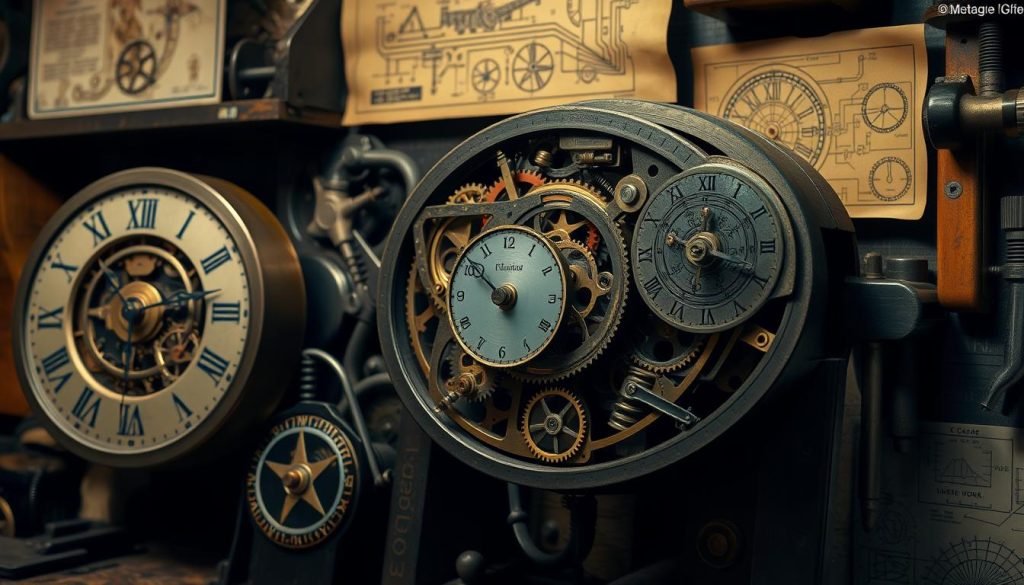
Both mechanical clocks and quartz clocks have their own special features. Knowing about the springs in different clocks helps us understand timekeeping better. It also shows how clock mechanisms have evolved over time.
| Clock Type | Spring Type | Power Source |
|---|---|---|
| Mechanical Clocks | Mainsprings and Balance Springs | Manual Winding |
| Quartz Clocks | None | Battery-Powered Quartz Crystal |
Modern Clock Mechanisms Without Springs
Timekeeping technology has changed a lot in recent years. Now, we have modern clock mechanisms that don’t need springs. These new systems are more accurate and reliable. For example, quartz clocks use a quartz crystal to keep perfect time.
Some key features of modern clock mechanisms include:
- Quartz movement technology, which utilizes a quartz crystal to regulate timekeeping
- Digital timekeeping systems, which use electronic signals to display the time
- Atomic clocks, which use the vibrations of atoms to measure time
These new clock mechanisms have changed how we keep time. They are more accurate and reliable than old spring-based systems. Quartz clocks are very popular because they are precise and easy to maintain. On the other hand, atomic clocks are the most accurate, keeping time with an error of just one second per million years.
As technology gets better, we’ll see even more new timekeeping ideas. For example, digital timekeeping systems have made timekeeping devices like smartwatches and computer clocks possible. These modern mechanisms without springs will become even more important in our daily lives.
| Clock Type | Description | Accuracy |
|---|---|---|
| Quartz Clocks | Use a quartz crystal to regulate timekeeping | High |
| Digital Timekeeping Systems | Use electronic signals to display the time | High |
| Atomic Clocks | Use the vibrations of atoms to measure time | Very High |
The Art of Spring-Driven Clockwork
The making of mechanical clocks shows our creativity and precision. These timepieces have complex mechanisms that need skill and care. Clock maintenance is also an art, needing a deep understanding of these systems.
Precision timepieces stand out because they keep perfect time. This is thanks to top-notch springs and precise mechanisms. The art of making these clocks is a mix of technology and beauty, creating sought-after pieces.
- Precise spring manufacturing
- Expert clock assembly and adjustment
- Regular clock maintenance to ensure optimal performance
These elements help make precision timepieces that are both accurate and beautiful.
The art of spring-driven clockwork is a testament to human creativity and innovation, and its beauty and complexity continue to inspire wonder and admiration.
Maintaining Spring-Based Clocks
Keeping your mechanical clock in good shape is key. Springs are vital for its accuracy. Regular care can stop problems like spring breakage or wear.
Common Spring Issues
Issues like over-winding can break the spring. Corrosion can weaken it over time. Catching these problems early can save your clock.
Professional Maintenance Tips
Experts say to clean and oil the clock often. They warn against DIY repairs. This can harm the clock’s delicate parts.
DIY Care Guidelines
Here’s how you can care for your clock at home:
- Keep the clock away from direct sunlight and moisture
- Avoid exposing the clock to extreme temperatures
- Use a soft cloth to dust the clock regularly
By following these tips and getting help when needed, you can keep your clock running well. Regular care is key to avoiding spring problems.
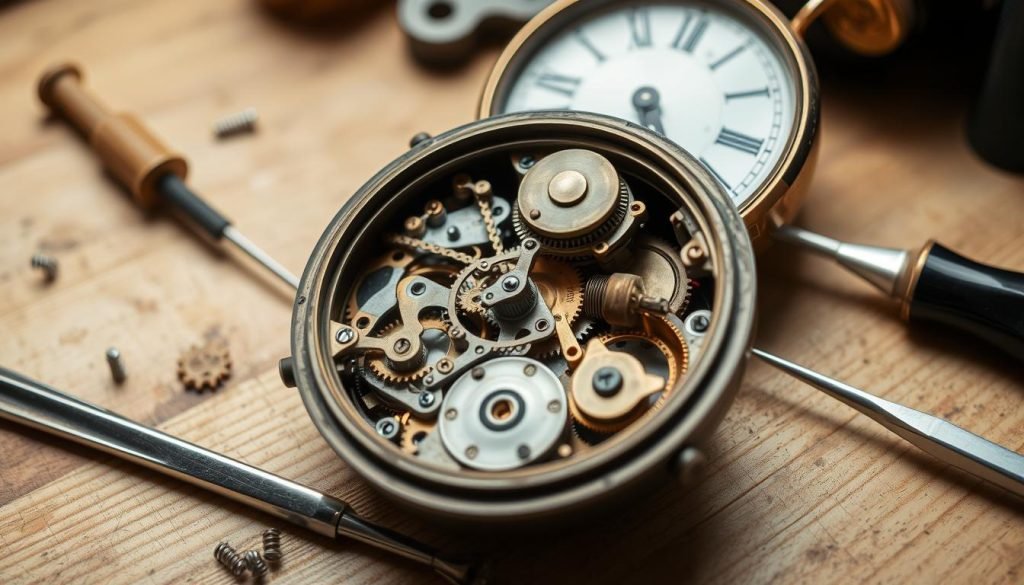
Comparing Different Clock Technologies
There are many clock technologies out there, like quartz, mechanical, and atomic clocks. Each has its own strengths and weaknesses. Quartz clocks are known for being accurate and affordable, making them great for daily use.
Mechanical clocks are loved for their beauty and craftsmanship. But, they might not be as accurate as quartz clocks and need more upkeep. Atomic clocks, on the other hand, are the most precise but also the priciest and most complex.
Here’s a quick look at how these clocks compare:
| Clock Technology | Accuracy | Maintenance | Cost |
|---|---|---|---|
| Quartz Clocks | High | Low | Affordable |
| Mechanical Clocks | Medium | High | Expensive |
| Atomic Clocks | Very High | Very Low | Very Expensive |
In conclusion, picking a clock technology depends on what you need and like. By looking at the good and bad of each, you can pick the right clock for you.
The Future of Clock Mechanisms
Looking ahead, innovative timekeeping will be key in the clock mechanism world. New tech will bring us more precise and green timekeeping tools. History shows us that precise clocks drive innovation, and this will keep happening.
Emerging tech will change clock mechanisms. We’ll see:
- Advanced materials and making methods
- Better quartz movement tech
- More digital timekeeping systems
These changes will make timekeeping more accurate and available to more people. We must keep traditional clock-making alive while using new tech. This way, clock-making will grow and change.
The clock mechanism future is bright and full of new things. With a focus on new timekeeping and keeping old methods alive, we’ll see big improvements. We’re excited for a future where timepieces are better, greener, and for everyone.
| Technology | Impact on Clock Mechanisms |
|---|---|
| Advanced Materials | Improved durability and accuracy |
| Quartz Movement | Increased precision and reliability |
| Digital Timekeeping | Enhanced functionality and accessibility |
Conclusion: The Enduring Legacy of Clock Springs
Exploring clock mechanics shows us how important clock springs are. They’ve been key in timekeeping’s growth. From old mechanical clocks to today’s precise ones, the clock spring keeps time moving smoothly.
These metal coils have brought innovation and a love for mechanical engineering. They’ve helped measure time well and inspired many to innovate. Looking ahead, clock springs will likely stay important in timekeeping, showing our past and future ingenuity.

